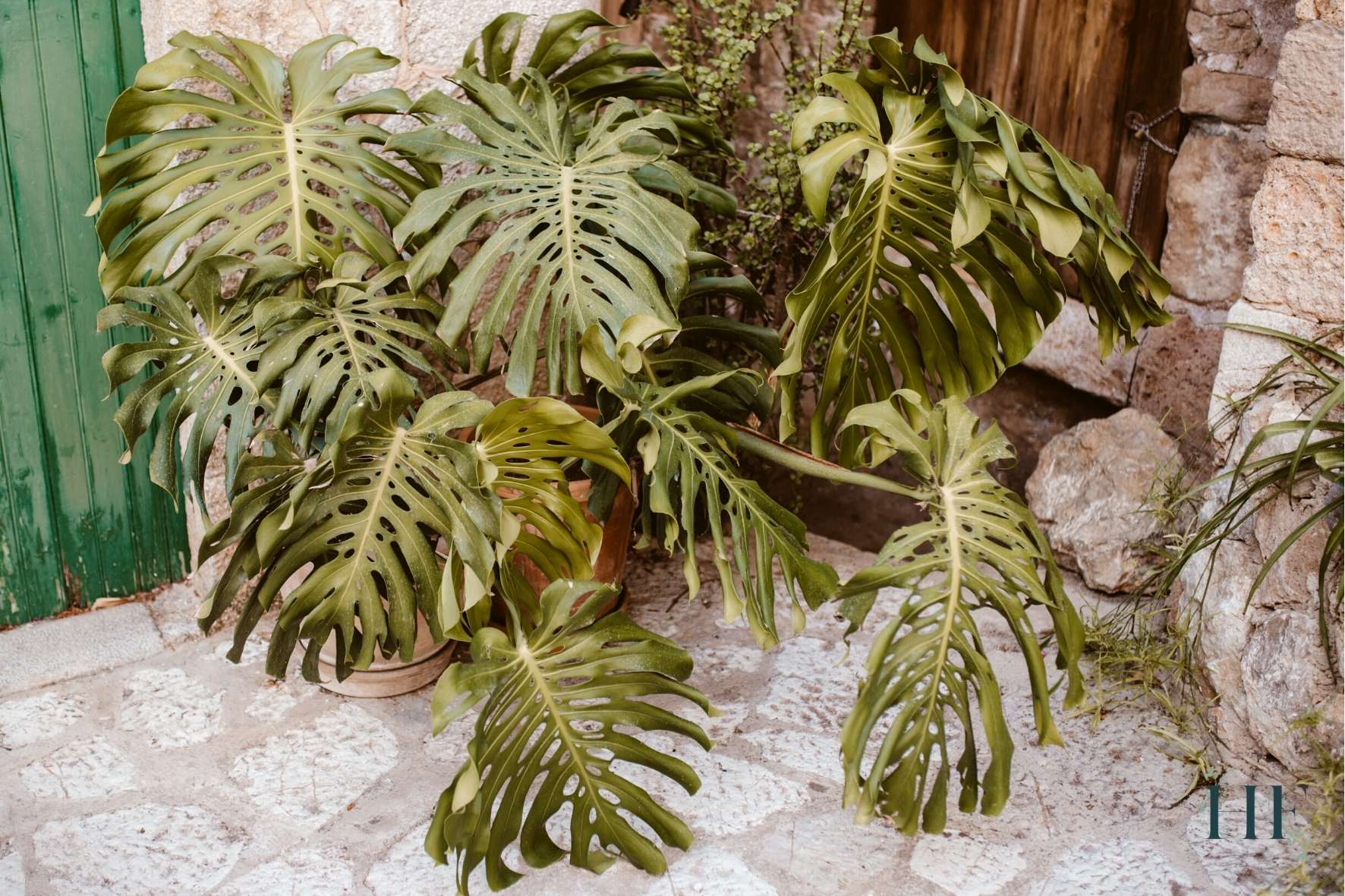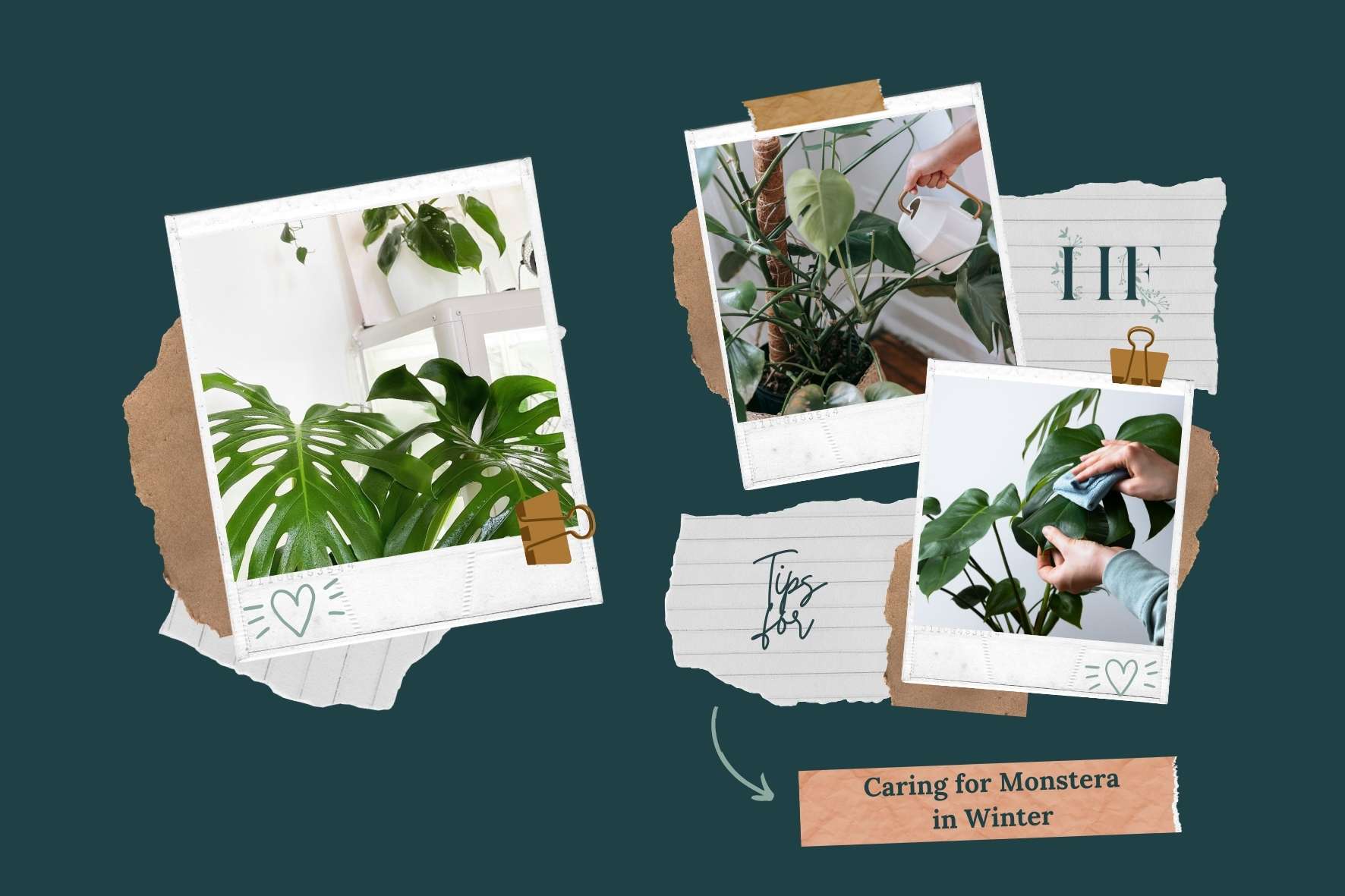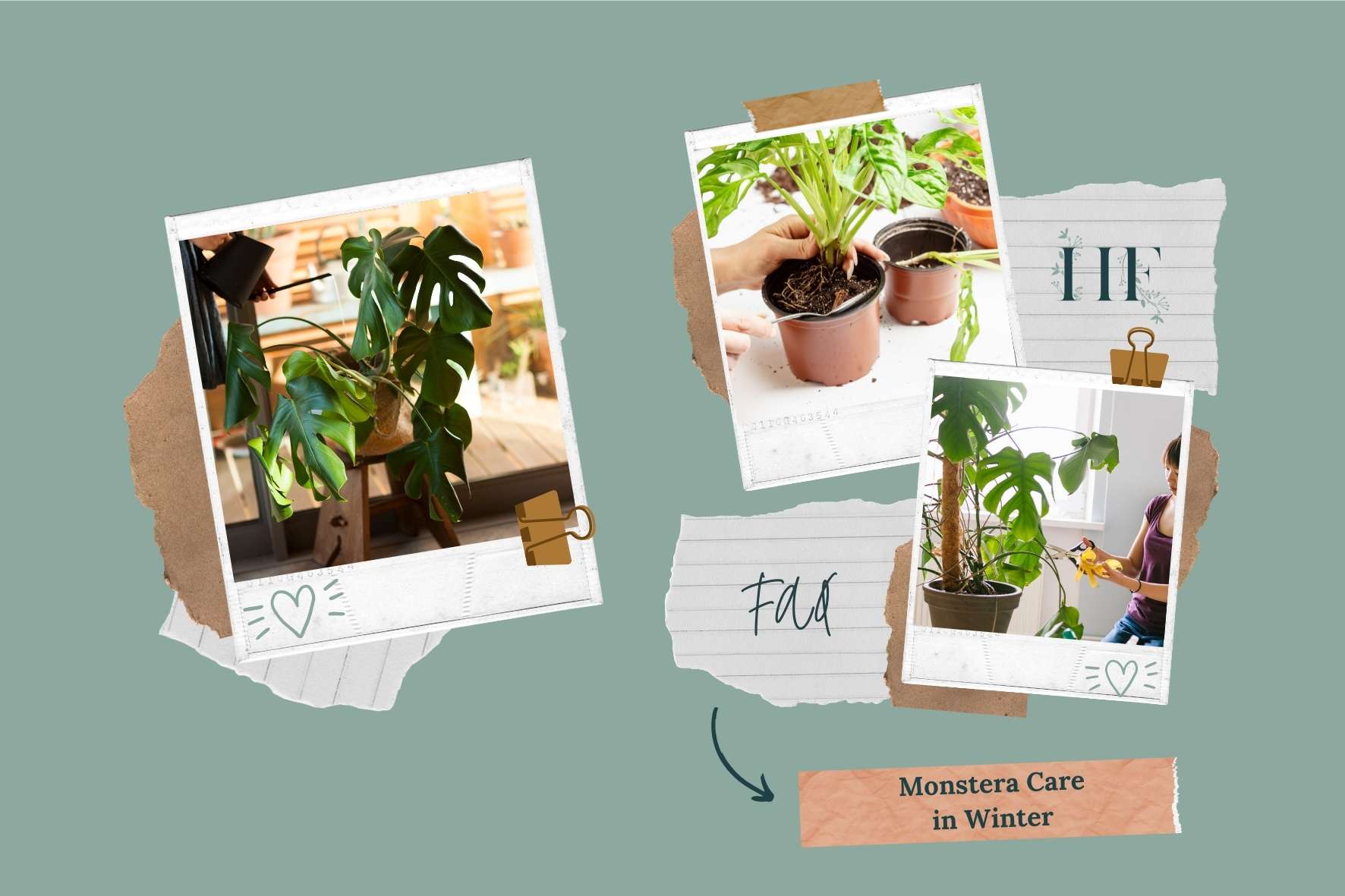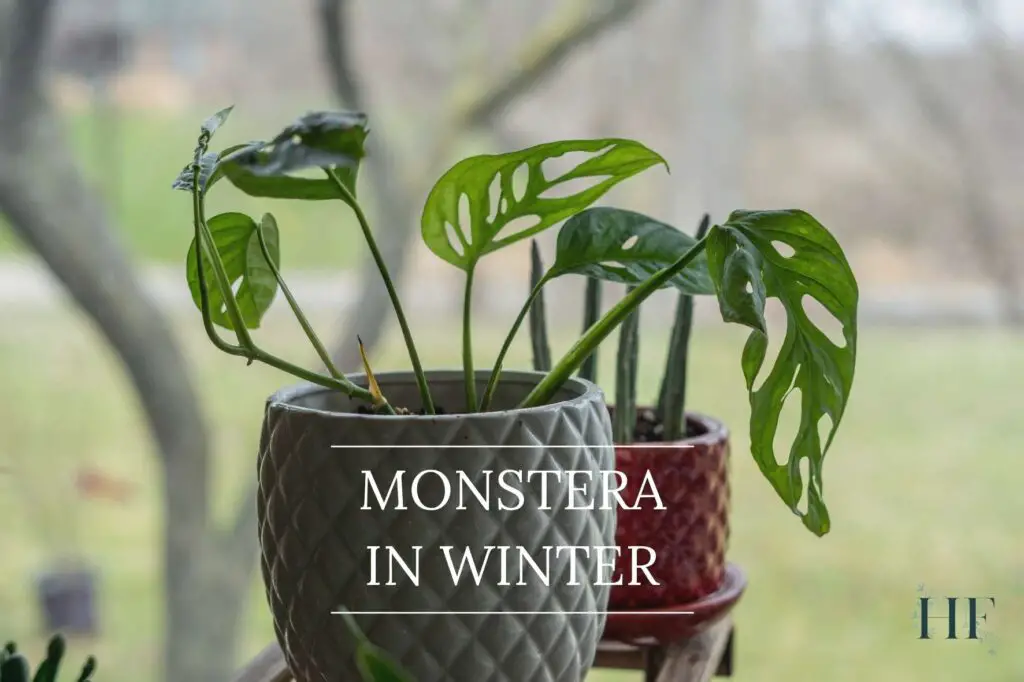Monsteras are incredibly resilient, but they do need a little extra care in winter, especially if you live you live in an area that gets cold in winter!
In this blog post, I will also explain what to take into account when growing Monsteras outside and how to take care of your Monstera plant in winter to make sure it survives.
Monstera Outside
Monstera Deliciosa (a.k.a. the Swiss Cheese Plant), Monstera Adansonii and other varieties are native to tropical regions of the Americas, where the temperatures are warm all year, averaging from 25 to 28ºC (77 to 82ºF).
That being said, you could probably grow your Monstera outside in the summer, even if you don’t live in a tropical climate.
Can I Put Monstera Outside?
Monsteras can be both indoor and outdoor plants. If you want your monstera to survive outdoors, then the outside temperature should ideally not go below 10ºC (50ºF) at any time of the year.
A Monstera’s ability to survive outside depends on the climate of the area in which you live. Monstera plants do best outside all year in areas with a USDA hardiness zone of 10 to 12. But it does depend on the variety you have, though.
Zone 10 ranges between extreme lows of 30 to 40ºF (-1 to 4ºC) and zone 12 ranges between 50 and 60ºF (10 to 16ºC). Zone 11 falls in between the two. In this zone are Hawaii, central and southern Florida, and parts of southern California, Puerto Rico, and other areas around the globe that fall in line with this longitude.
In the U.K., a Monstera’s hardiness is H1B, which means that it can be grown outside in the summer as long as the temperature doesn’t go lower than 10 to 15ºC (50 to 59ºF).
In Europe, a Monstera can live outside in certain temperate regions like the Mediterranean coast and Brittany (the Bretagne region in France).
A steady minimum temperature of at least 13 to 15°C (55–59°F) is preferable for Monsteras growing outside since it allows continuous growth. Growth ceases below 10°C (50°F) and a Monstera will be killed by frost.
That’s why locations prone to freeze won’t be able to accommodate a Monstera outside in the winter but may be able to do so in the summer.
For hardiness zone details depending on Monstera variety, check The Ultimate Guide to Monstera Varieties (22 Types) blog post, where I give specific care advice for each type of Monstera.

Monstera Outside in Winter
So, can I leave my Monstera outside in winter?
You can keep Monstera outside in winter somewhere warm and frost-free, such as the inside of a greenhouse or conservatory (unless you live in a tropical area or hardy zone).
If you don’t have access to one of those, you can keep the Montera on its planter outside, but make sure you bring it indoors when temperatures go lower than 10°C (50°F) and before the first frosts set in.
When indoors, a Montera’s temperature should be between 20 to 30°C (68 to 86 °F). Also, avoid cold drafts and direct airflow from heaters in the winter months. The latter will affect its humidity levels, which you want to keep between 40% to 60%.
Place your Monstera near a window, especially one facing East or South, to ensure that it gets enough light.
Insider Tip: Growing your Monstera in a pot allows you to move it around with the seasonal changes. A mobile Monstera allows you to bring it inside for the winter, cutting the likelihood of it getting caught outside when it is too cold.
When growing outdoors in winter, ideally the temperature should stay between 20 to 30°C (68 to 86 °F) to promote healthy growth.
If your Monstera is planted in the ground because you live in a tropical location (or hardy zone), but it suffers from frost damage, you can prune the affected leaves in spring. Leaving damaged leaves on the plant can help to protect the other leaves and central stem.
Monstera Outside in Summer
You can keep your Monstera outside in summer in an area that has bright indirect light and shade. An east-facing location is ideal, so your plant can enjoy the morning sun and afternoon shade.
Just avoid direct sunlight since a Monstera is more likely to burn and wilt. Remember that the intensity of the sun outdoors is higher than indoors.
Also, be aware that a Monstera’s watering needs outdoors will be higher too, so adjust your watering schedule according to the weather and your plant’s requirements.
Monstera in Winter FAQ
What Happens to Monstera Plants During the Winter?
Monsteras are naturally tropical plants, so in winter they go into a period of dormancy in which their growth slows or even stops.
During autumn and winter in the northern hemisphere, Monstera plants will be mostly dormant because the lack of sunlight slows down photosynthesis.
Can Monstera Survive Winter?
Monsteras can survive winter outside as long as temperatures don’t go below 10°C (50°F).
Monsteras will start to struggle when the temperature is under 10°C (50°F). Moreover, all Monstera varieties cannot withstand frost, which means that they cannot survive freezing temperatures.
A light frost will cause the leaves to burn and turn brown; a stronger frost will kill your plant.
When Should I Bring My Monstera Inside?
As a rule of thumb, you should bring your Monstera indoors or into a greenhouse once the temperature drops below 10°C (50°F) to avoid your plant dying due to frost.
How Do I Know If My Monstera Is Too Cold?
Cold temperatures will shock your Monstera, eventually killing it.
Monstera cold damage signs include:
- Burnt and brown leaves.
- Droopy leaves.
- Leaf discolouration.
- Plant wilting.
- Blackened foliage.
- Loose root ball.

How to Care for Monstera in Winter
How do you take care of a Monstera in the winter?
There are a few things that you will have to adjust when caring for a Monstera in winter:
| MONSTERA CARE | IN WINTER |
|---|---|
| Light | Place 2 to 4 feet (0.6 to 1.2 m) away from a window with access to bright, indirect sunlight. |
| Water | Water every 14 to 21 days after making sure that the topsoil is dry. |
| Fertilizer | Stop fertilizing during winter. |
| Humidity | Use a humidifier to increase the moisture levels. |
| Pests problems | Insecticidal soap or neem oil work to get rid of pests. |
1) Adjust Location for Optimal Lighting
In winter, as the days shorten, your Monstera will get less and weaker sunlight.
So, to keep your Monstera happy and supply enough sunlight, you can move it to a sunnier window during winter (the lower light season in the Northern hemisphere).
For instance, if your Monstera is on an east-facing location during summer, you move it to a south-facing location during winter so it gets more sunlight.
Ideally, you should keep your Monstera in a spot that receives bright indirect light 2 to 4 feet (0.6 to 1.2 m) removed from a south-facing window (or north-facing, if you live south of the equator) during the winter months.
If your Monstera is low light for most of the day, you can supplement your Monstera’s light needs with grow lights.
A lack of light is not an immediate emergency, however, this can eventually cause stunted growth, resulting in a “leggy Monstera” over time.
This full-spectrum grow light comes with a timer and you can clip it to a shelf. If you already have a lamp, you can get a Sansi bulb, which is affordable and does a good job too.
Read also: Monstera Light Requirements – How Much Does It Need?
2) Decrease Watering Frequency
As a rule of thumb, you should water your Monstera less in winter as they are in their dormant period (i.e., they are not actively growing) and their water requirements reduce.
So, during the autumn and winter months (in the northern hemisphere), you can water your Monstera every 14 to 21 days after making sure that the topsoil is dry.
Too much water, or too frequent watering, can cause your plant to become waterlogged and at risk of root rot.
Insider Tip: If it takes longer than two weeks for the topsoil to dry out, you can increase the amount of sunlight your plant receives.
Read also: A Guide to Monstera Water Needs (How Often and When).
3) Stop Fertilizing Altogether
Plants only need fertilizer when they are actively growing, which happens during the spring and summer months.
Since Monsteras are dormant during winter, their growth slows down (or they stop growing altogether), so there’s no need to fertilize a Monstera in winter.
You can resume your fertilizing schedule in spring.
Read also: A Guide to Monstera Nutrients (Why, When and How to Fertilise).

4) Increase Room Humidity
Monsteras live in a humid environment all year round in their natural habitat.
As houseplants, Monsteras also thrive in humid environments. That’s why Monsteras need a humidity level between 40% to 60% all year (including winter). This range is also applicable for variegated Monsteras.
During summer, it might be easier for you to cater to those needs. But, in winter, houses can get dry due to heaters running for most of the day.
So, to keep the humidity steady or to bring it up in winter, here’s what you can do:
- Turn on your humidifier (the most effective method, I must admit).
- If you don’t have one, place a pebble tray near or under your Monstera pot.
- You could also move your Monstera to a more humid room like the laundry room, kitchen or bathroom (as long as there’s enough sunlight or you can supplement it with grow lights).
Read also: Monstera Humidity & Temperature Needs – 7 Tips to Get It Right.
5) Check for Pest Infestation
If you put your Monstera outside for the summer and bring it back inside once the temperatures get too cold, then you will need to check for pests.
Common pests that affect Monstera plants include:
- Mealybugs: They are a very common pest that can be stubborn to eliminate. They feast on the plant’s sap, damaging the plants. You can find them in the areas where your stems and leaves meet.
- Solution for mealybugs: Insecticidal soap or neem oil.
- Spider mites: They create webbing between the stems and leaves, and suck the sap out of leaves, which turns the leaves yellow.
- Solution for spider mites: Insecticidal soap or neem oil.
- Scale insects: They attach themselves to the underside of leaves and feed off of the plant. Like mealybugs, they are quite obstinate.
- Solution for scale insects: Insecticidal soap or neem oil.
Insider Tip: The first measure when you spot a pest infestation should be to quarantine your Monstera plant to prevent the infestation from spreading.
Read also: 11 Monstera Pests and Diseases Plus How to Get Rid of Them.
6) Keep The Leaves Free of Dust
Last, but not least, keep your Monstera leaves clean.
Since your Monstera will require less frequent care during winter, it might be easy to forget about dust accumulating on their leaves.
Clean your Monstera’s leaves every 2 weeks to prevent dust from accumulating. This will help your Monstera absorb sunlight and moisture without a problem.
Dust inhibits the plant’s ability to photosynthesize. Essentially, it clogs their pores, preventing them from “breathing.”
You can use a wet soft cloth (I use a microfibre cloth) to remove the dust. Remember that all parts of a Monstera are toxic, causing skin irritation, so you might want to use a pair of gloves when cleaning its leaves.

Caring for Monstera in Winter FAQ
Should I Repot Monstera in Winter?
Generally, winter isn’t the best time to repot a Monstera plant. But if you have to, then wait until mid to late winter time (i.e., closer to spring).
Your Monstera is more likely to bounce back in spring, or closer to it, so repotting in that period will be less stressful as your plant will be coming out it’s dormancy period.
In other words…
The best time of year to repot your Monstera is in early spring, just as it is approaching the growing season. Early spring gives your plant the greatest chance to adjust to the new conditions in a different pot and fresh soil.
However, you can repot your Monstera plant at any time of the year, if you notice urgent signs that it requires repotting. In such a case, your plant may need extra care to prevent it from becoming distressed after the transplantation.
Insider Tip: When it is time to repot your Monstera plant, choose a pot no more than 2 inches (5 cm) wider in diameter than its current pot. Too much extra room can cause the soil to hold on to too much moisture, leading to root rot.
Read also: A Guide to Repotting Monstera (When, Why and How).
Can I Propagate Monstera in Winter?
You can propagate cuttings from your Swiss Cheese plant any time of the year. But, to ensure your Monstera propagation is successful, it’s best to do it at the right time of year.
Spring is the best time of year to take cuttings from a Monstera to propagate. This is because the plant is coming out of dormancy from the colder months (autumn and winter) and entering its strongest growing period.
You can still have success propagating in the early Autumn, but the process is likely to take much longer. Also, you may need to supplement lighting using artificial lights to promote its growth.
If you choose to propagate in winter (in the northern hemisphere), it will take a little longer because the plant doesn’t grow as fast during this time of year. Also, the success rate lowers due to lack of sunlight, lower temperatures and less humidity in the air.
Read also: A Guide to Monstera Propagation in Soil, Water and more!
How Often Do You Water Monstera in Winter?
As mentioned earlier, during the autumn and winter months (that is in the northern hemisphere), you can water your Monstera every 14 to 21 days after making sure that the topsoil is dry.
You can use your finger to check that the topsoil is dry while the soil feels moist 1 to 2 inches below the surface.
Water your Monstera thoroughly until the soil is evenly moist and water runs from the drainage holes.
Read also: A Guide to Monstera Water Needs (How Often and When).
Do Monsteras Grow New Leaves in Winter?
Monsteras are dormant during autumn and winter, which means that their growth rate slows down or completely stops until spring comes.
In the northern hemisphere, it is less likely to spot a new leaf unfurling in winter. But, it highly depends on where you live and the climate in your area.
However, you can expect new growth if the environmental conditions don’t change much compared to summertime i.e. when your Monstera is still getting plenty of light and humidity, and there’s hardly any temperature change.
If you live in a tropical or sub-tropical climate, your Monstera might grow new leaves every couple of weeks.
Read also: Monstera Growth Rate, Life Cycle and Lifespan Facts and Tips.
Do You Feed Monstera in Winter?
There’s no need to feed a Monstera in winter since they are dormant. This means that their growth slows down or stops altogether.
You can fertilize your Monstera in spring and summer to support its growth but completely stop during autumn and winter.
Read also: A Guide to Monstera Nutrients (Why, When and How to Fertilise).
Pruning Monstera in Winter?
The worst time to prune a Monstera is autumn and winter since it’s when it will enter dormancy. There is simply inadequate sunlight for photosynthesis to fuel growth and repair damage caused by pruning.
I would suggest waiting until early spring, just before the growing season begins. This is the best time to prune a Monstera plant because it ensures your plant will have the resources it needs to recover from any stress or damage from pruning and be ready to send out a flush of new growth.
Read also: A Guide to Monstera Pruning (How, When and Why).

